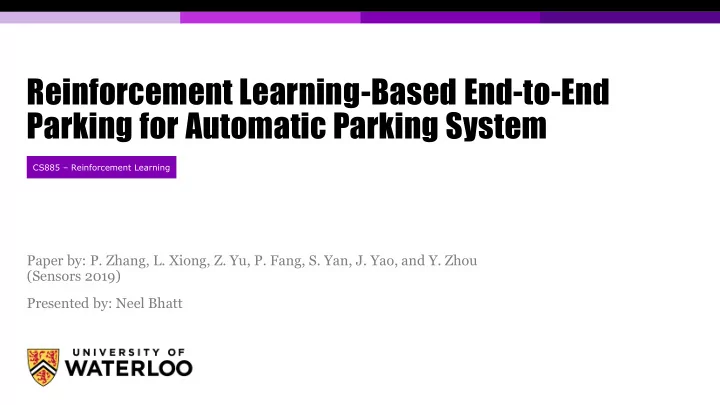

Reinforcement Learning-Based End-to-End Parking for Automatic Parking System CS885 – Reinforcement Learning Paper by: P. Zhang, L. Xiong, Z. Yu, P. Fang, S. Yan, J. Yao, and Y. Zhou (Sensors 2019) Presented by: Neel Bhatt
Context and Motivation High density urban parking facilities can benefit from an automated parking system (APS): Increase parking safety Enhance utilization rate and convenience BS ISO 16787-2016 stipulates parking inclination angle to be confined within ±3° This paper focuses on a DDPG based end-to- end automated parking algorithm End-to-End DDPG APS University of Waterloo – Neel Bhatt PAGE 2
Related Work Path Planning Consists of predefined trajectory functions: B-splines, 𝜃 3 -splines, Reeds-Shepp curves Involves geometric numerical optimization of the curve parameters subject to vehicle non- holonomic constraints Path Tracking Often accomplished through feedforward control using 2DOF vehicle dynamics model Proportional-Integral-Differential (PID) Control Sliding Mode Control (SMC) End-to-End DDPG APS University of Waterloo – Neel Bhatt PAGE 3
Problem Background and MDP Formulation The features of the parking spot include T and L shaped markings In an end-to-end scheme, these features are identified and represented internally In this paper, a separate vision based detection module (with tracking) is used End-to-End DDPG APS University of Waterloo – Neel Bhatt PAGE 4
Problem Background and MDP Formulation The state, 𝑡 , consists of features that correspond to coordinates of the 4 corners of the desired parking spot The action, 𝑏 , refers to the continuous space of steering angle provided by the APS The state transition function, 𝑈 , is unknown and not modelled explicitly End-to-End DDPG APS University of Waterloo – Neel Bhatt PAGE 5
Problem Background and MDP Formulation The reward, 𝑠 , is formulated as: 𝑠 = 𝑆 𝑑𝑞 + 𝑆 𝑚 + 𝑆 𝑒 Deviation from the center of the parking spot and attitude error: 𝑆 𝑑𝑞 = Line Pressing: 𝑆 𝑚 = −10 Lateral Bias: 𝑆 𝑒 = −10 End-to-End DDPG APS University of Waterloo – Neel Bhatt PAGE 6
Deep Deterministic Policy Gradient (DDPG) DDPG is a model-free, off-policy actor-critic algorithm based on DPG End-to-End DDPG APS University of Waterloo – Neel Bhatt PAGE 7
DDPG – Training Process Note that the action features are included as network inputs A target Q network is updated based on the hyperparameter 𝜐 < 1 The temporal difference between the target and Q network are used perform gradient updates The parameters of the Q network are updated by minimizing the MSE loss function as in DQN End-to-End DDPG APS University of Waterloo – Neel Bhatt PAGE 8
DDPG – Training Process The actor is trained using the DPG theorem: A target 𝜌 network is updated based on the hyperparameter 𝜐 < 1 The presence of the Q function gradient over actions points to utilizing this Q function gradient as an error signal to update actor parameters End-to-End DDPG APS University of Waterloo – Neel Bhatt PAGE 9
Network Architecture Critic Actor End-to-End DDPG APS University of Waterloo – Neel Bhatt PAGE 10
Overall Scheme End-to-End DDPG APS University of Waterloo – Neel Bhatt PAGE 11
Experimental Evaluation – 60° Initial approach angles: 60,45, and 30° Attitude inclination error: -0.747° Path planning and tracking approaches such as PID and SMC show > 3° attidude error 60° End-to-End DDPG APS University of Waterloo – Neel Bhatt PAGE 12
Experimental Evaluation – 45 and 30° The attitude error remain < 1° for initial attitude angles of 45 and 30° 45° 30° End-to-End DDPG APS University of Waterloo – Neel Bhatt PAGE 13
Discussion and Critique Significant improvement in inclination error Path Planning vs RL generated path: tracking issues Tracking cannot be customized in unseen scenarios Cases where approach angle is 90° Is the claim of the approach being “end -to- end” valid? DDPG can learn policies end-to-end based on original paper Future directions: Inverse RL to mitigate sub-optimal reward convergence due to handcrafted reward scheme End-to-End DDPG APS University of Waterloo – Neel Bhatt PAGE 14
Recommend
More recommend